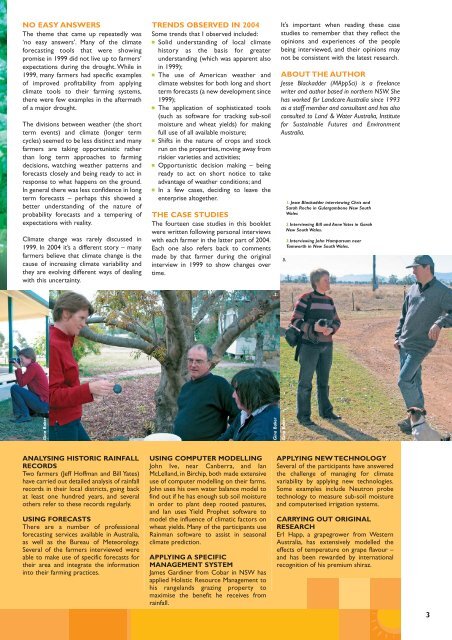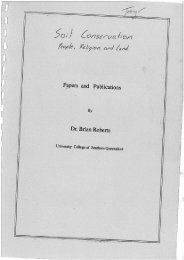Masters of the Climate: Innovative farmers ... - South West NRM
Masters of the Climate: Innovative farmers ... - South West NRM
Masters of the Climate: Innovative farmers ... - South West NRM
You also want an ePaper? Increase the reach of your titles
YUMPU automatically turns print PDFs into web optimized ePapers that Google loves.
NO EASY ANSWERS<br />
The <strong>the</strong>me that came up repeatedly was<br />
‘no easy answers’. Many <strong>of</strong> <strong>the</strong> climate<br />
forecasting tools that were showing<br />
promise in 1999 did not live up to <strong>farmers</strong>’<br />
expectations during <strong>the</strong> drought. While in<br />
1999, many <strong>farmers</strong> had specific examples<br />
<strong>of</strong> improved pr<strong>of</strong>itability from applying<br />
climate tools to <strong>the</strong>ir farming systems,<br />
<strong>the</strong>re were few examples in <strong>the</strong> aftermath<br />
<strong>of</strong> a major drought.<br />
The divisions between wea<strong>the</strong>r (<strong>the</strong> short<br />
term events) and climate (longer term<br />
cycles) seemed to be less distinct and many<br />
<strong>farmers</strong> are taking opportunistic ra<strong>the</strong>r<br />
than long term approaches to farming<br />
decisions, watching wea<strong>the</strong>r patterns and<br />
forecasts closely and being ready to act in<br />
response to what happens on <strong>the</strong> ground.<br />
In general <strong>the</strong>re was less confidence in long<br />
term forecasts – perhaps this showed a<br />
better understanding <strong>of</strong> <strong>the</strong> nature <strong>of</strong><br />
probability forecasts and a tempering <strong>of</strong><br />
expectations with reality.<br />
<strong>Climate</strong> change was rarely discussed in<br />
1999. In 2004 it’s a different story – many<br />
<strong>farmers</strong> believe that climate change is <strong>the</strong><br />
cause <strong>of</strong> increasing climate variability and<br />
<strong>the</strong>y are evolving different ways <strong>of</strong> dealing<br />
with this uncertainty.<br />
TRENDS OBSERVED IN 2004<br />
Some trends that I observed included:<br />
Solid understanding <strong>of</strong> local climate<br />
history as <strong>the</strong> basis for greater<br />
understanding (which was apparent also<br />
in 1999);<br />
The use <strong>of</strong> American wea<strong>the</strong>r and<br />
climate websites for both long and short<br />
term forecasts (a new development since<br />
1999);<br />
The application <strong>of</strong> sophisticated tools<br />
(such as s<strong>of</strong>tware for tracking sub-soil<br />
moisture and wheat yields) for making<br />
full use <strong>of</strong> all available moisture;<br />
Shifts in <strong>the</strong> nature <strong>of</strong> crops and stock<br />
run on <strong>the</strong> properties, moving away from<br />
riskier varieties and activities;<br />
Opportunistic decision making – being<br />
ready to act on short notice to take<br />
advantage <strong>of</strong> wea<strong>the</strong>r conditions; and<br />
In a few cases, deciding to leave <strong>the</strong><br />
enterprise altoge<strong>the</strong>r.<br />
THE CASE STUDIES<br />
The fourteen case studies in this booklet<br />
were written following personal interviews<br />
with each farmer in <strong>the</strong> latter part <strong>of</strong> 2004.<br />
Each one also refers back to comments<br />
made by that farmer during <strong>the</strong> original<br />
interview in 1999 to show changes over<br />
time.<br />
It’s important when reading <strong>the</strong>se case<br />
studies to remember that <strong>the</strong>y reflect <strong>the</strong><br />
opinions and experiences <strong>of</strong> <strong>the</strong> people<br />
being interviewed, and <strong>the</strong>ir opinions may<br />
not be consistent with <strong>the</strong> latest research.<br />
ABOUT THE AUTHOR<br />
Jesse Blackadder (MAppSci) is a freelance<br />
writer and author based in nor<strong>the</strong>rn NSW. She<br />
has worked for Landcare Australia since 1993<br />
as a staff member and consultant and has also<br />
consulted to Land & Water Australia, Institute<br />
for Sustainable Futures and Environment<br />
Australia.<br />
3.<br />
1. Jesse Blackadder interviewing Chris and<br />
Sarah Roche in Gulargambone New <strong>South</strong><br />
Wales<br />
2.Interviewing Bill and Anne Yates in Garah<br />
New <strong>South</strong> Wales.<br />
3.Interviewing John Hamparsum near<br />
Tamworth in New <strong>South</strong> Wales.<br />
2.<br />
Gina Baker<br />
Gina Baker<br />
Gina Baker<br />
ANALYSING HISTORIC RAINFALL<br />
RECORDS<br />
Two <strong>farmers</strong> (Jeff H<strong>of</strong>fman and Bill Yates)<br />
have carried out detailed analysis <strong>of</strong> rainfall<br />
records in <strong>the</strong>ir local districts, going back<br />
at least one hundred years, and several<br />
o<strong>the</strong>rs refer to <strong>the</strong>se records regularly.<br />
USING FORECASTS<br />
There are a number <strong>of</strong> pr<strong>of</strong>essional<br />
forecasting services available in Australia,<br />
as well as <strong>the</strong> Bureau <strong>of</strong> Meteorology.<br />
Several <strong>of</strong> <strong>the</strong> <strong>farmers</strong> interviewed were<br />
able to make use <strong>of</strong> specific forecasts for<br />
<strong>the</strong>ir area and integrate <strong>the</strong> information<br />
into <strong>the</strong>ir farming practices.<br />
USING COMPUTER MODELLING<br />
John Ive, near Canberra, and Ian<br />
McLelland, in Birchip, both made extensive<br />
use <strong>of</strong> computer modelling on <strong>the</strong>ir farms.<br />
John uses his own water balance model to<br />
find out if he has enough sub soil moisture<br />
in order to plant deep rooted pastures,<br />
and Ian uses Yield Prophet s<strong>of</strong>tware to<br />
model <strong>the</strong> influence <strong>of</strong> climatic factors on<br />
wheat yields. Many <strong>of</strong> <strong>the</strong> participants use<br />
Rainman s<strong>of</strong>tware to assist in seasonal<br />
climate prediction.<br />
APPLYING A SPECIFIC<br />
MANAGEMENT SYSTEM<br />
James Gardiner from Cobar in NSW has<br />
applied Holistic Resource Management to<br />
his rangelands grazing property to<br />
maximise <strong>the</strong> benefit he receives from<br />
rainfall.<br />
APPLYING NEW TECHNOLOGY<br />
Several <strong>of</strong> <strong>the</strong> participants have answered<br />
<strong>the</strong> challenge <strong>of</strong> managing for climate<br />
variability by applying new technologies.<br />
Some examples include Neutron probe<br />
technology to measure sub-soil moisture<br />
and computerised irrigation systems.<br />
CARRYING OUT ORIGINAL<br />
RESEARCH<br />
Erl Happ, a grapegrower from <strong>West</strong>ern<br />
Australia, has extensively modelled <strong>the</strong><br />
effects <strong>of</strong> temperature on grape flavour –<br />
and has been rewarded by international<br />
recognition <strong>of</strong> his premium shiraz.<br />
3
















